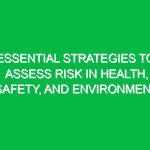Introduction
In the realm of health, safety, and environmental (HSE) management, understanding the flammability of chemicals is crucial. The question, “Are all chemicals flammable?” touches on the fundamental principles of Chemical Safety and risk management. Not all chemicals are created equal; some can ignite and burn, while others are stable and non-flammable under normal conditions. This article delves into the intricacies of chemical flammability, its implications for HSE practices, and the essential insights every professional in the field should know.
The Basics of Chemical Flammability
To grasp the concept of chemical flammability, it’s important to define what flammability means. Flammability refers to the ability of a substance to ignite and sustain combustion. This property varies widely among different chemicals, influenced by their physical and chemical characteristics.
Not all chemicals are flammable; in fact, many are considered non-flammable or have low flammability. The classification of chemicals regarding their flammability can be broken down into several categories:
- Flammable Liquids: These are liquids that can easily catch fire at normal temperatures. They have a flash point below 60°C (140°F). Common examples include gasoline and acetone.
- Combustible Liquids: These liquids have a flash point above 60°C but below 93°C (200°F). Examples include diesel fuel and some oils.
- Flammable Solids: These are solid materials that can ignite through friction, heat, or sparks. Examples include magnesium and sulfur.
- Gases: Many gases are flammable, including propane and natural gas, while others, like nitrogen and carbon dioxide, are not.
Understanding these categories helps in implementing proper Safety Measures in workplaces where chemicals are handled.
Flammability and Its Implications in HSE
The implications of chemical flammability within the HSE context are significant. When chemicals are mishandled or improperly stored, they pose severe risks, including Fires, explosions, and exposure to hazardous substances.
Here are key considerations regarding chemical flammability in HSE practices:
1. Risk Assessment
A thorough risk assessment is vital to identify flammable chemicals within a workplace. This process involves evaluating the potential sources of ignition, the presence of flammable materials, and the likelihood of an accident occurring.
For instance, consider a manufacturing plant that uses flammable solvents. The risk assessment should include:
- Identifying storage areas for solvents.
- Evaluating ventilation systems to prevent vapor accumulation.
- Assessing the Training of employees in handling flammable materials.
2. Proper Storage and Handling
Storing and handling flammable chemicals requires strict adherence to Safety protocols. The National Fire Protection Association (NFPA) provides guidelines on the safe storage of flammable liquids, which include:
- Using approved containers for storage.
- Labeling storage areas clearly.
- Ensuring proper ventilation to disperse fumes.
In a real-life scenario, an industrial facility once faced a minor explosion due to improper storage of flammable solvents in an unventilated area. This incident underscores the importance of proper handling and storage practices.
3. Employee Training and Awareness
Employee training is a cornerstone of HSE management, particularly when it comes to flammable chemicals. Workers should be educated on the properties of the chemicals they handle, emergency response protocols, and safe work practices. Regular drills and refresher courses can significantly enhance Workplace Safety.
For example, a chemical processing plant implemented a training program that included hands-on demonstrations of how to use fire extinguishers on small fires caused by flammable chemicals. This proactive measure not only improved employee confidence but also reduced response time during an actual emergency.
4. Emergency Response Planning
Having a robust emergency response plan is essential for any facility that handles flammable materials. This plan should outline clear Procedures for:
- Evacuating personnel in case of a fire.
- Reporting incidents to the appropriate authorities.
- Using fire control equipment effectively.
In a hypothetical scenario, imagine a laboratory where a flammable chemical spill occurs. Without an effective emergency response plan, the risk of a fire spreading increases dramatically. However, with a well-practiced plan, employees can respond swiftly and safely.
Regulations and Standards Governing Chemical Flammability
Various Regulations and standards govern the handling of flammable chemicals to ensure Workplace Safety. Understanding these regulations is essential for compliance and risk management. Some key regulations include:
1. Occupational Safety and Health Administration (OSHA)
osha sets forth standards for the safe handling of hazardous chemicals, including flammable materials. The Hazard Communication Standard (HCS) requires that all chemicals be appropriately labeled and that Safety data sheets (SDS) be readily available.
2. National Fire Protection Association (NFPA)
The NFPA establishes codes and standards, including the NFPA 30, which specifically addresses flammable and combustible liquids. This standard provides guidelines for the storage, handling, and use of these materials.
3. Environmental Protection Agency (EPA)
The EPA regulates hazardous waste under the Resource Conservation and Recovery Act (RCRA), which impacts how flammable chemicals are disposed of. Compliance with these regulations is crucial to prevent environmental contamination and promote Sustainability.
Conclusion
In conclusion, while not all chemicals are flammable, understanding the properties and risks associated with flammable substances is critical in the HSE domain. Proper risk assessment, storage, handling, employee training, and adherence to regulations are essential components of a robust safety framework.
By prioritizing these practices, organizations can mitigate the risks associated with flammable chemicals, ensuring a safer workplace for all. As professionals in the field of health, safety, and Environment, it is our responsibility to remain vigilant and informed about the materials we handle. Continued education and proactive measures will lead to safer environments and a more sustainable future.
As you reflect on the importance of chemical flammability in your organization, consider conducting a review of your current practices and regulations. Are you doing enough to protect your employees and the environment from the risks posed by flammable substances?


